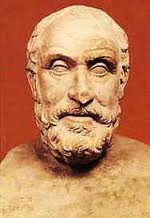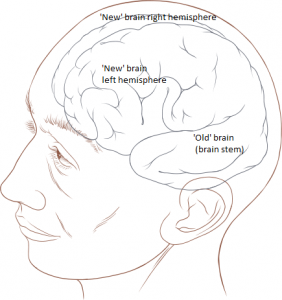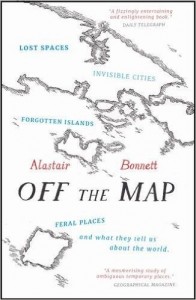Pyrrhonian Scepticism is central to the Middle Way, and is an approach now being advocated by Stephen Batchelor and Christopher Beckwith, among others: but both of these tend to concentrate on the historical questions rather than the meaning and implications of scepticism. There is a basic Western intellectual block on Pyrrhonian scepticism being properly understood when figures like this appeal to it, because it has been misunderstood for so long. There are some very basic and important arguments at stake as to why it has been misunderstood: why there is nothing negative about scepticism; why even the most full-blooded scepticism is fully compatible with properly interpreted science; and why there can be no such thing as ‘extreme’ scepticism.
I have tried to put forward a full academic argument to explain that misunderstanding in a paper available on researchgate or academia.edu. The shorter essay that follows here, though, is intended to be a bit more popular in approach. It was written for a website called Scientia Salon which, with impeccably bad timing as far as I was concerned, decided to close and stop accepting new contributions shortly after I had submitted it. There is nowhere else suitable to send it. Although it is a bit longer than is usual for blogs on this site, I have decided to publish it here as the best available destination for it.
What is scepticism? The word ‘sceptic’ (or ‘skeptic’ for Americans) has popularly come to mean a denialist, one who merely takes a contrary position to a more established one under discussion. Thus we have ‘Climate Change Sceptic’ – one who denies the conclusions reached by a global consensus of scientists on climate change, and ‘Euro-Sceptic’ a term used in Britain for those who want withdrawal from the EU. Then there is the widespread use of ‘sceptic’ or ‘skeptic’ by those whose arguments are underpinned by scientific naturalism. There too, it can be associated with denial – in this case of supernatural religious claims and pseudoscience. An average member of the public could be easily forgiven for having the impression that ‘scepticism’ means denial: that is, the holding of negative positions.
If you look at the doctrines of the ancient Greek founder of Scepticism, Pyrrho, however, there is no trace of denial being typical of scepticism. Although we have none of the writings of Pyrrho himself, we do have those of his later Roman follower, Sextus Empiricus, and this offers the best source on the movement known as ‘Pyrrhonism’[i]. The Pyrrhonian sceptics did not adopt any negative positions, but on the contrary disagreed with the rival ‘Academic’ sceptics of the time, when the latter claimed that sceptical arguments implied negative positions. The Pyrrhonians instead cultivated ‘equipollence’ – that is, a balanced state in which one bears in mind the lack of justification for either positive or negative positions. The state of equipollence had a practical and therapeutic purpose in the philosophy of Pyrrhonism, as by avoiding commitments to either positive or negative opinions one could free one’s mind and achieve a state of calm fulfilment known as ataraxia. For the Pyrrhonians, then, sceptical argument was a means of detaching oneself from both positive and negative dogmas and reaching a more balanced and integrated state of mind. It was to this end that they employed philosophical arguments questioning every possible area of claimed knowledge.
Compared to this ancient use, then the modern use of the whole idea of scepticism involves a misunderstanding. I want to suggest that this is a misunderstanding of the basic implications of sceptical arguments. Of course, words do change their meanings over time, and I do not want to present a naive argument that Pyrrhonian scepticism is right because it is ‘original’, or that the older form is better just because it is older. Instead, I suggest that the arguments need to be epistemological and pragmatic. The Pyrrhonian sceptics have been badly misunderstood by most philosophers (and indeed, classicists and other academics too) for at least the last 500 years or so: misunderstood in the sense that we did not recognise the value of what they were offering us. Instead of cultivators of balanced judgement, we interpreted the sceptics as polarised controversialists. To this day, perhaps partially as a result, their modern imitators emphasise polarised controversy rather than balanced judgement. But polarised controversy adds little or nothing to intellectual and public life, whilst balanced judgement can add a great deal of adequacy.
How did we get from the equipollence of the Pyrrhonians to the polarised denials of the Climate Change ‘sceptics’? It seems clear that it is the misinterpretations of philosophers that are overwhelmingly to blame, and that this misinterpretation continues to dominate all discussion of scepticism to this day. To explain how this misinterpretation has arisen I will need to first make a quick survey of what the sceptical arguments are.
Sceptics offer us a range of philosophical arguments that oblige us to recognise the uncertainty of knowledge-claims. Some of the earliest ones are the ‘Ten Modes of Pyrrhonism’, which include arguments from the limitations of our senses and from our position in space and time to remind us of the uncertainty of empirical claims. For example, the changes in our bodies over time mean that when I put my hand in warm water, then remove it and put it into cold water, the cold water will seem freezing rather than merely cold. These types of argument have been developed by later philosophers into the ‘Argument from Illusion’ (which points out that, given that our perceptions are sometimes subject to illusion, we can never be certain that they are not currently under an illusion) and the ‘Dream Argument’ (which points out that the totality of our experience may be illusory: I cannot prove that I am not dreaming at this moment).
However, it is not only empirical arguments that are subject to scepticism. The infinite regress of justifications involves a sceptical questioning of the justification of any claim, even an a priori claim such as a definitional or mathematical claim. Whatever justification I may give for believing that 2+2=4, that justification can itself be questioned, and so on ad infinitum.
These well established arguments are quite enough by themselves to refute virtually any claim to knowledge, but more recently they have been further buttressed by the arising of linguistic forms of scepticism. These focus on the relationship between the way our language tries to represent the world and the world itself, and points out that the categories used by language relate to the world only in a way that is both relative to our position and more or less vague. We rely on a strict correspondence between our linguistic categories and the world if we are to have certainty. For example, if I claim to know that ‘Paris is the capital of France’, this fails to take into account that people may have different ideas about exactly what constitutes ‘France’, ’Paris’ and ‘capital’ and that these concepts have fuzzy edges. I can thus not be certain about the correctness of this claim. There may be some people who interpret ‘capital’ outside the conventions we normally apply to the idea, and there may be some suburbs, or even millimetres of ground around the boundary, that may or may not be part of Paris – so we do not precisely know even what ‘Paris’ is.
The problem with philosophers’ responses to sceptical arguments has usually been that they are seen as a threat. Descartes, for example, tried to overcome sceptical argument through appeal to the unique individual experience of thinking, which he believed offered him certainty[ii]. Hume, on the other hand, did not believe that there were any such easy refutations, but nevertheless argued that we were constitutionally or naturally unable to take scepticism seriously[iii]. Whether scepticism was conquered (by the Cartesians) or sidelined (by the Humeans), the basic misconception lay in the problematising of scepticism in the first place. Later philosophers seem to have done little to reverse this misconception, with Wittgenstein applying narrow criteria of meaningfulness to argue that sceptical arguments were linguistically invalid[iv], and most modern analytic epistemologists virtually ignoring scepticism to concentrate on intuition-mongering about our knowledge concepts.
Against this background, to argue that scepticism is not just harmless, but actually beneficial, seems to involve an Emperor-has-no-clothes kind of assertion, but certainly one that it is my philosophical duty to offer. The core argument is one about the implications of sceptical arguments themselves. Why do we have a problem with someone pointing out that our ‘knowledge’ is uncertain? Presumably because we crave certainty. But that is a psychological complaint that we need to engage with through a personal practice of working to come to terms with uncertainty (the very therapeutic process that the Pyrrhonians offered), not something we need to project into philosophical arguments. Personally I have concluded that sceptical arguments are irrefutable, but I don’t want to divert this essay into the complex process of surveying all the attempted refutations and their failure, for this would distract us from the bigger and more important point: why should we want to refute scepticism in the first place? If a doctor tells us that we have a certain disease, do we want to ‘refute’ that? No, at least in most cases we recognise that the diagnosis is necessary and helpful. Why, then, do we want to ‘refute’ someone who points out that we are subject to a disease of craving certainty?
Of course, if scepticism had anything at all to do with denial, then there would be a distinct danger of the cure being just as bad as the disease, and thus the diagnosis being in vain. We might give up one set of certainties only to be delivered into another, negative set. So this is where we need a further clear argument in the spirit of the Pyrrhonians, namely, that sceptical arguments apply just as much to denials or negative claims as they do to positive ones. All you have to do to test this is to apply common sceptical arguments to negative claims – and you will find they work just as well. For example, imagine I look round my office and assert ‘The German Chancellor is not in my office’. Well, how can I be completely certain about that? It’s possible, though not at all likely, that she may be hiding within these four walls in a form that I do not yet know about, and that my belief in the absence of a German Chancellor is mistaken – just as my belief in the presence of an armchair might possibly be mistaken.
However, the equal uncertainty of negative assertions is a point often missed in modern debate on a whole range of issues, where a mere doubt is over-interpreted as grounds for denial. So-called Climate Change sceptics, for example, do not merely doubt the evidence about the anthropogenic origins of Climate Change, but draw the conclusion that Climate Change is either unreal or caused by factors other than human activity. Mere limitations or ambiguities in the evidence, however, do not justify any such conclusion. Similarly in debates about God, the strong reasons for doubting God’s existence in no way justify an atheist conclusion (assuming that ‘atheism’ means the denial of God’s existence), only an agnostic one.
Another misinterpretation which must then be met is that of the supposed absurdity of scepticism. To put forward a sceptical argument you often have to consider the possibility of extremely unlikely scenarios: whether that is the scenario of Angela Merkel hiding in my office, or the scenario of my whole day so far having been a dream. Philosophical refutations of scepticism often proceed by arguing that such scenarios are (linguistically or epistemologically) invalid in some way, and ‘sensibly’ arguing that we should not accept them. For example, Bertrand Russell used the example of an orbiting teapot, which he argued we should not believe in even though we cannot rule it out[v]. But to target such unlikely scenarios as elements of sceptical argument is to misconstrue the goal of sceptical arguments. They do not advocate belief in such scenarios, but merely require us to face up to their possibility as a method of recognising uncertainty. A possibility, in this case, does not involve a claim about logic, but rather one about a negligible probability that is nevertheless present.
Cognitive psychologists have identified experimentally the difficulties people have with treating small probabilities in a proportionate way, simply because they take hold of our imaginations[vi]: thus those who are irrationally afraid of flying remain uncomforted by statistics about the low level of flying fatalities, because any risk is envisaged as a real threat. In dealing with scepticism we have to make a conscious effort to avoid this cognitive bias: the 0.0000…1% chance that Angela Merkel is hiding in my office deprives me of certainty that she is not, but does not need to distort my judgements about practical matters. I do not need to go and prepare kaffee and kuchen to entertain her.
If sceptics are not in fact seriously putting forward highly unlikely scenarios, we should also not assume that they in any way threaten our judgement about highly likely ones. I need have no anxiety that my armchair will cease to exist at the moment I start to sit down on it. That implies that sceptical arguments are no threat to scientific claims that are made in a context of provisionality (as opposed to ones that assume total certainty). Most scientists, when questioned on this point, will agree at least in theory that all science is provisional and subject to further evidence. Scepticism, then, merely reminds them of this provisionality, which is a beneficial service, not a threat of any kind.
The mistaken assumption that scepticism is a threat to justified beliefs has also resulted in a widespread philosophical distinction between ‘extreme’ and ‘moderate’ (or ‘mitigated’) scepticism. However, the sceptical arguments I have been discussing above are of a thoroughly ‘global’ sort. They are full-bloodedly sceptical, but nevertheless not at all ‘extreme’, nor do they need ‘mitigating’. Once we recognise that full sceptical argument does not involve negative claims, we do not need to be at all partial in our acceptance of them. On the contrary, we need to be suspicious of those who apply sceptical argument selectively rather than even-handedly. For example, it is very common in arguments between theists and atheists for one side to merely use sceptical arguments against the commitments of the other, whilst remaining apparently entirely oblivious to the ways in which their own assumptions are equally open to sceptical argument. Thus both sides supply powerful arguments for agnosticism – which they then systematically over-interpret.
Perhaps the crucial issue at stake in avoiding the misinterpretation of scepticism, however, is that of what types of belief it is we can avoid by employing (and accepting) sceptical argument. Again, I am not going to go into historical or interpretational questions about what any particular sceptical philosopher ‘really meant’ here, but rather ask what the implication of sceptical arguments themselves might be. Given that these arguments apply just as much to negative claims as to positive ones, we cannot assume that the target of sceptical argument is only positive belief. If we accept, on the other hand, that beliefs can be provisional, and that provisional beliefs are not threatened by scepticism, however ‘global’ in nature, then scepticism is obviously directed against non-provisional beliefs, whether these are positive or negative. The term used by the Pyrrhonian sceptics for non-provisional beliefs was dogma.
How do we tell the difference between dogma and provisional belief? The traditional answers to such a question in philosophy have either tended to involve appeals to foundational facts of some kind (God, a priori truths, common sense etc) or to rationality. However, none of these ways of distinguishing dogma from provisional belief are themselves sceptic-proof. Any foundational claim can be rendered uncertain by sceptical argument, and reasoning, no matter how rigorous, always requires premises to start with – and those premises can be doubted. Instead, however, modern psychology and neuroscience offer us a whole set of new ways of understanding dogma and provisionality. We need to see dogma and provisionality in terms of the states of mind or brain that we apply to our judgements, rather than in terms of purely philosophical criteria. Perhaps in that way we will be able to understand more closely what the ancient Sceptics were on about.
Perhaps the most powerful and interesting contribution that scientific evidence has made to understanding dogma comes from brain lateralisation studies. These have been wonderfully compiled and applied in Iain McGilchrist’s boundary-busting book ‘The Master and his Emissary’, which is about the over-dominance of the left hemisphere of the brain over the right, and its effects on human culture and history[vii]. The evidence about brain lateralisation reveals the ways in which the left hemisphere of the brain tends to specialise in explicit, conceptual, and goal-orientated representations of the world, whilst the right tends to be implicit, to make metaphorical links, and to be open to internal and external experience rather than focused on goals. It is the linguistic and goal-driven areas of the human brain, together with the frontal lobes, that seem to have developed most strongly in early human evolution, allowing us to make and communicate clear linguistic representations of events that are not present. However, it is this very ability that also creates the danger of over-dependence on those representations, which can get ‘stuck’ and become the obsessive objects of dogmatic belief. The very ability that enables us to dominate our environment so strongly can also lead us to start living in a fantasy world and ignoring contrary new information coming in from the outside via the right hemisphere. Dogma, then, broadly speaking, is over-dominant left-hemisphere representation, and provisional belief is better integrated belief that is more effectively connected to new information coming through the right hemisphere.
Cognitive psychology also offers further evidence that can help us to differentiate dogma from provisionality. It has identified a wide range of cognitive biases that appear to be common human tendencies, all of which involve absolutisation[viii]. Perhaps the most basic of these (and the one that influences all the others) is Confirmation Bias. Confirmation Bias involves the selection of evidence to fit the theory we are trying to prove, with the unconscious exclusion of falsifying evidence. It seems, from psychological evidence, that we all have the tendency to seek out confirmatory evidence rather than falsifying evidence[ix]. Here, then, lie the roots of dogma – in the exclusion of alternative possibilities.
An explanatory framework for the operation of dogma can thus be found in the mechanism of repression. If we hold a more psychologically adequate conception of belief that allows beliefs to be implicit rather than merely explicit, dogmatic beliefs can be seen as those that block alternative explanations of the same experiences. Provisional beliefs, on the other hand, are of no less value in helping us structure and act in the world around us, but at the same time they allow potential access to other possibilities, no matter how unlikely. Neural networking theory can also give us an account of what is meant by ‘accessing’ an alternative, which can mean the availability of at least a weak neural link. The more weak neural links we have created (for the access of our imaginations), the greater our capacity to access alternatives to a dominant explanation.
It is exactly these ‘possibilities’ that have been such a soft target for hard-nosed philosophers misunderstanding scepticism. But sceptics are helping to make us aware of the value of a capacity for accessing alternatives, at the same time as warning us about the dangers of adhering to one particular over-dominant left hemisphere model in a constantly changing environment. Sceptical awareness supports our adaptability as individuals and as a species, as well as enabling advances in scientific understanding. The role of scepticism, then, is thoroughly practical – and yet the philosophical travesty of it that has developed somehow portrays it as ridiculously impractical.
The implications of taking scepticism seriously are huge. They involve a shift from an attempt to find idealised ‘truth’ to a more realistic focus on the avoidance of error. If we can avoid identifiable errors in the way in which we engage with the world around us, that gives us a head start in our understanding of it through greater adequacy of judgement – focusing on the judgement itself rather than its object. The ancient Sceptics utilised some of the kinds of personal practices popular amongst all the schools of the Hellenistic Philosophy of which they were a part, some of which we might now call meditation or reflection[x]. Scientific investigation into the benefits of mindfulness meditation reveal some of its benefits in supporting more provisional judgements[xi] –benefits that may be compounded when combined with training in Critical Thinking. Provisionality is not just a philosophical commitment, but a mental habit that we have to keep working at.
Another important implication of this way of understanding scepticism is the removal of the fact-value distinction, closely allied to the reason-emotion distinction – the strong use of which can be found at the bottom of a good deal of both philosophical and scientific thinking since the eighteenth century. The ancient Sceptics made no such assumptions, and for them the avoidance of dogma was clearly as much of a moral goal as a cognitive one. The sources of dogmatic thinking, and the absolute claims targeted by scepticism, cut equally across facts and values. To support their assumption, there is also the complete absence of any clear division between reason and emotion in the operations of the brain[xii]. To avoid error, then, is also to avoid evil: a discovery that requires a complete reconstruction of widespread philosophical assumptions about ethics. The practice of avoiding errors created by dogma is just as much an emotional as a cognitive process, and just as much a matter of judging better values as of judging better facts to believe in.
Why isn’t training in maintaining provisionality as a personal practice a basic part of every education, especially a scientific education? Mainly, I would suggest, because scepticism has been misunderstood. Whilst sceptics were using philosophical arguments as a pointer to the practice of provisionality and the improvement of judgement, the post-Renaissance tradition of thought, on re-discovering sceptical argument, interpreted those arguments only as intellectual puzzles, and completely neglected the practical context in which they could be used. It has taken the subsequent development of psychology and of psychotherapeutic techniques (including the adoption of mindfulness practices from Eastern traditions) to at last open us up to the point where we might be able to start appreciating the full value of what the sceptics were offering. The recognition of that value, and the exploration of its implications, involves nothing less than a paradigm shift in the way we do philosophy.
[i] See Benson Mates (1996) The Skeptic Way: Sextus Empiricus’s ‘Outlines of Pyrrhonism’.Oxford University Press, New York
[ii] Rene Descartes (1641) trans. F.E. Sutcliffe (1968), Meditations. Penguin, London
[iii] David Hume (1777/1975) An Enquiry Concerning Human Understanding. Oxford University Press, Oxford
[iv] Ludwig Wittgenstein, trans G.E.M. Anscombe (1967) Philosophical Investigations. Blackwell, Oxford
[v] Bertrand Russell “Is there a God?” (1952) http://russell.mcmaster.ca/cpbr11p69.pdf
[vi] Daniel Kahneman, Thinking Fast and Slow (2011) Penguin, London (ch.29)
[vii] Iain McGilchrist, The Master and His Emissary (2009). Yale University Press, New Haven
[viii] I have explained the absolutisation element in a wide range of cognitive biases in Robert M. Ellis (2015) Middle Way Philosophy 4: The Integration of Belief. Lulu, Raleigh
[ix] P.C. Wason (1960) “On the failure to eliminate hypotheses in a conceptual task”: Quarterly Journal of Experimental Psychology 12:3; Clifford Mynatt et al (1977) “Confirmation bias in a simulated research environment” Quarterly Journal of Experimental Psychology 29:1
[x] Pierre Hadot, Philosophy as a Way of Life (1995) Blackwell, Oxford; Martha Nussbaum, The Therapy of Desire (1994). Princeton University Press, Princeton.
[xi] Daniel Siegel The Mindful Brain (2007) Norton, New York; A. Jha et al (2007) “Mindfulness training modifies subsystems of attention”: Cognitive, Affective, and Behavioral Neuroscience 7:2
[xii] Justin Storbeck & Gerald Clore (2007) “On the interdependence of cognition and emotion”: Cognition and emotion 21:6





